CINERAMA 2012 | Read more at in70mm.com The 70mm Newsletter |
| Written by: Michael J. Cahill. Article and all the photos are Copyright © 2012. | Date: 17.01.2012 |
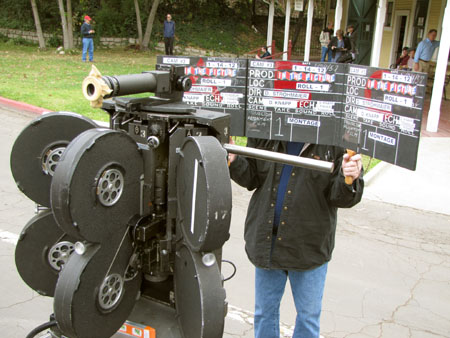 David Tondeur (our Camera assistant) holding the Cinerama Slate. (Note that Dave did not want to erase the chalk date from 1957, the last time this slate was used. So he just taped the new info over it.) David Tondeur (our Camera assistant) holding the Cinerama Slate. (Note that Dave did not want to erase the chalk date from 1957, the last time this slate was used. So he just taped the new info over it.)I am standing here face to face with an actual Cinerama camera. We’re adjacent to the Ventura Freeway, and across the street from the Hollywood Bowl flanked by green grass, palm trees and pin oaks. Here on the other side of Highland Avenue is a spacious yellow clapboard building reminiscent of a frontier general store. A clever soul might recognize it as the livery stable from the TV show “Bonanza”. It is also in fact the original “Barn” — the very first movie production studio in Hollywood, used by Cecil B. DeMille to create the first feature length film made in tinsel town, “The Squaw Man”. The Barn is currently kept in good stead as an historic landmark and houses the Hollywood Heritage Museum; who by the way has been gracious enough to permit filming. | More in 70mm reading: "In the Picture" - Now Shooting in70mm.com's Cinerama page "How The West Was Won" "Keepers of the Frame" - complete press kit "Cinerama Adventure" Internet link: See behind the scene footage on YouTube |
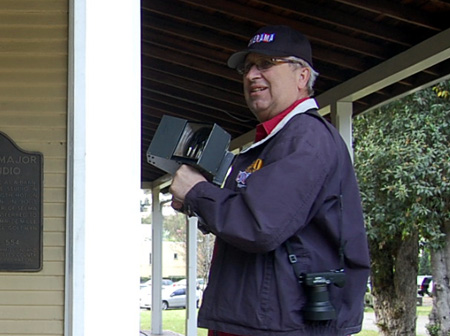 John Sittig, Exec producer, checks out the second shot of the day with the Viewfinder John Sittig, Exec producer, checks out the second shot of the day with the ViewfinderIt is Saturday January 14, 2012 and today the Barn is the centerpiece for a brief scene in an all-new short film for Cinerama called “In the Picture”, produced by Anthony Saenz and directed by Dave Strohmaier. It’s an odd configuration of hardware for anyone unfamiliar with a Cinerama motion picture camera. And yet, once you get your mind around the optical physics of how Cinerama is projected, studying this camera becomes an appreciation of sheer simplicity. This equipment is sixty years old if it’s a day. And yet there’s an elemental elegance to this design that incorporates what is essentially three separate cameras unified by a single master control and a singular super-widescreen vision. | |
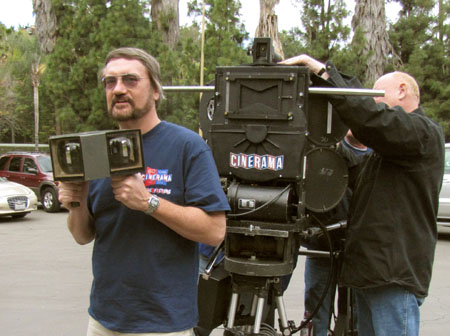 Dave Strohmaier using the director’s viewfinder to line up the second shot of the day. Dave Strohmaier using the director’s viewfinder to line up the second shot of the day.I had previously seen photos of this mechanical behemoth and understood the novel concept of Cinerama, having enjoyed their most celebrated production "How The West Was Won". But seeing it up close gave me an unanticipated jolt. You must understand that Cinerama is not merely “widescreen”. Any triple-image, curved screen encounter, when well executed, is a thrilling event. When you’re so immersed in a film that literally surrounds your senses, it quickly becomes apparent that the peripheral nature of human eyesight has been sorely underappreciated, and underutilized, by the film industry as a whole. | |
 The crew and some of the actors just before Dave calls “Action” on the first take of the day. And with the megaphone far right is Randy Gitsch, Associate Producer on this film and stepped in at the last minute as Dave’s A.D. Randy also produced “Cinerama Adventure” with Dave. The crew and some of the actors just before Dave calls “Action” on the first take of the day. And with the megaphone far right is Randy Gitsch, Associate Producer on this film and stepped in at the last minute as Dave’s A.D. Randy also produced “Cinerama Adventure” with Dave.This three-panel process may not be everyone’s cup of java. But in the grand scheme of epic filmmaking, Cinerama stands squarely at the head of the crowd for sheer entertainment value and spectacle. Camera and crew vehicles arrived around 9:00 and by 10:40 the massive Cinerama camera has been uncased and set up on a balloon-tired dolly. The camera’s three mouse-eared magazines mounted at carefully calculated adjacent angles are reminiscent of the blades jutting from the back of a Triceratops. The camera’s tall flat rectangular face sports a single bow tie shutter opening near the top. When the extra wide shutter blade is open you can see the three perfectly aligned 27mm lenses just behind it. | |
 Dave posing with the Cinerama camera crew. Fellow with the moustache is Ken Stone, the second fellow from the left is David Tondeur (camera assistant). Kneeling in front of the camera next to David is our Doug Knapp (DP). Next to David and holding the viewfinder is Dave Strohmaier (Director). Standing behind Dave in the green shirt is Lance Fisher (camera operator). Dave posing with the Cinerama camera crew. Fellow with the moustache is Ken Stone, the second fellow from the left is David Tondeur (camera assistant). Kneeling in front of the camera next to David is our Doug Knapp (DP). Next to David and holding the viewfinder is Dave Strohmaier (Director). Standing behind Dave in the green shirt is Lance Fisher (camera operator).The camera, its magazines, three batteries, cables, tripod, massive director’s viewfinder and triple slate are all original hardware provided by Cinerama for this production. The only crucial piece of non-Cinerama gear on loan today is the four-wheeled dolly, which has its own unique history. This particular dolly was used by Paramount studios on the original “Star Trek” TV show. There’s something mildly ironic about all this equipment that fifty years back in one way or another represented futuristic, bleeding edge technology. Now half a century down the road is it still in perfect working order. Though this girthy contraption lacks the muscular and aerodynamic lines of more contemporary cameras, the design carries with it a sort of sturdy confidence. It’s not a cruiser; it’s an aircraft carrier doing triple duty with delicate synchronicity. Once upon a time the few Cinerama cameras remaining had suffered from disuse. But thanks to the mechanical ingenuity of Ken Stone, this particular camera was rebuilt and fully restored to its original state of rock solid precision. | |
 Doug Knapp (our D.P.) using one of the viewfinders from behind the Camera. Doug Knapp (our D.P.) using one of the viewfinders from behind the Camera.The cinematographer operating in the DP position today is Doug Knapp who works closely with fellow camera assistant David Tondeur and camera operator Lance Fisher. The entire camera crew is in concert with director Dave Strohmaier’s vision of the scene at hand. In defiance of every cliché’ about “sunny California”, this particular Saturday is hung with a powder gray canopy, meaning the crew will not be fighting the hard yellow light and contrasty shadows inherent in Hollywood. Thanks to a veil of stratospheric diffusion, we’re favored with nice even ambient light. The first shot is a dolly move, a gentle push to establish the locale. Film archivist and historian Stan Taffel has wrangled about 30 background players, many of whom happen to be Cinerama aficionados—the smiles in every shot are genuine. I’ve been on more than my share of film sets and this one had the constant hum of pleasant chatter and an overall easygoing demeanor. Watches are checked regularly but nobody is hurrying. We want to get this right. Dave is in constant motion, positioning the players and giving them bits of business for the shot. He walks the scene through five or six rehearsals, each time tracking the action with a specialized three-lensed director’s viewfinder. (This is in fact the very viewfinder once used by Henry Hathaway and John Ford on "How The West Was Won".) Strohmaier puts you at ease right away and is quick to joke and smile. The company responds well to his lead and is anxious to please. | |
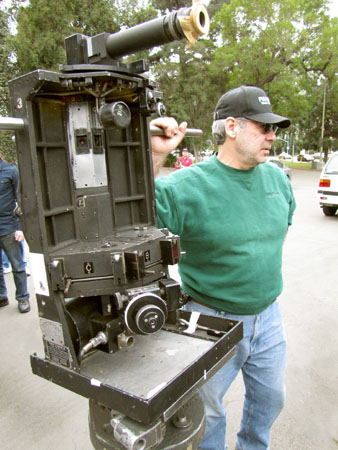 The back of the Cinerama camera with all three film magazines removed. You don’t see this every day. And the fellow in the green shirt is camera operator Lance Fisher. The back of the Cinerama camera with all three film magazines removed. You don’t see this every day. And the fellow in the green shirt is camera operator Lance Fisher.Dave confers with the camera crew to double check the technical side of the set up. In classic Cinerama form, the camera will film at 26 frames per second. And the crew is careful to make certain the composition doesn’t have any actors or key elements straddling the frame lines where the two side panels meet the middle one. Though the cloud cover provides some nice diffusion, its density shifts with the wind and light levels tend to drift. So Doug keeps referring to his light meter and adjusts the aperture so that all three lenses match perfectly. Slating the first shot is a quite something to see. The Cinerama slate is a larger than normal affair with three separately marked slates, hinged together with handles on the bottom of the first and third (or the “A” and “C”) slates. The contraption is about 14-inches high and, when extended, spans about four feet across. Today camera assistant David Tondeur is pulling double duty, earning the honor of pre-slating the first shot and then running the camera’s master control for the actual takes. He must angle the slate so that each panel is perpendicular to its appropriate camera lens. | |
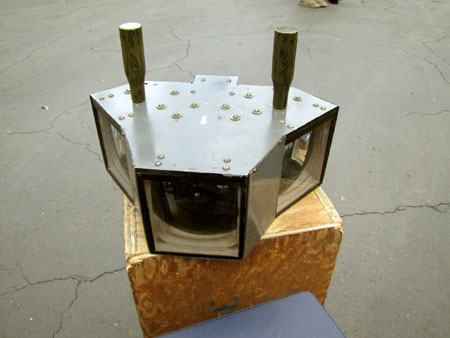 The Cinerama triple lens director’s viewfinder (used by John Ford and Henry Hathaway during “How the West Was Won”. The Cinerama triple lens director’s viewfinder (used by John Ford and Henry Hathaway during “How the West Was Won”.Firing up the camera itself is yet another treat for the senses. This thing makes some noticeable noise with its massive shutter flying in front of all three lenses while three belt-driven magazine spindles are whirring their little carriage motors like crazy. Add to this mix the low-pitched and precise ratcheting chitter of three film transports simultaneously clawing hundreds of sprocket holes through the three film gate housings and you’ve got a fairly exhilarating little mechanical symphony going on. Once this trio of meticulously interlaced camera systems begins working in perfect concert you start to notice more smiles behind the camera than in front. When we finally roll on the first take I am reminded that once upon a time live music was played while shooting silent films to set the mood for the actors. | |
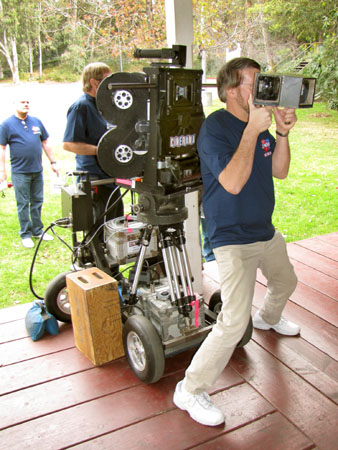 Dave Strohmaier in front of the Cinerama camera holding the three way viewfinder. Dave Strohmaier in front of the Cinerama camera holding the three way viewfinder.One imagines that a massive blimp for this camera must have been employed for any dialogue scenes in the original Cinerama films. But since everything we’re covering today is MOS (or “mit out sound”, as Michael Curtiz might say) then the camera’s native vocalizations serve as a tonic for this cast and crew. It is welcome mood music indeed. The camera rolls and we know we are in heady company. There is no “on” switch for a Cinerama camera but rather a master control box hard cabled to the camera body. On Doug Knapp’s command to “Roll camera”, David Tondeur turns the frame rate knob from zero to a precise 26 FPS and carries the master control at the end of an umbilical as he walks along side the camera during each take. At “Cut!” he backs down to zero. Care must be taken that all three camera batteries carry a full charge to insure synchronicity among all three film carriages. | |
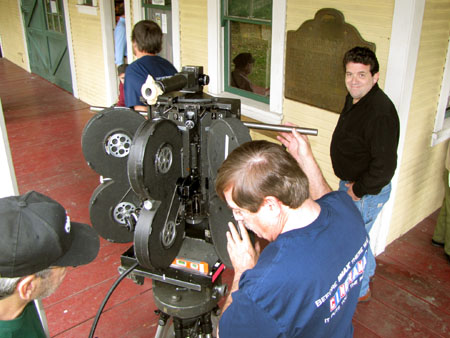 A nice view of the Cinerama camera’s magazine array. The gentleman in the black shirt is film archivist and historian Stan Taffel. He is a very good friend of Dave’s and was responsible for wrangling the background players for the shoot. Stan is also featured in the scene at the Barn as well as being a board member of Hollywood Heritage. A nice view of the Cinerama camera’s magazine array. The gentleman in the black shirt is film archivist and historian Stan Taffel. He is a very good friend of Dave’s and was responsible for wrangling the background players for the shoot. Stan is also featured in the scene at the Barn as well as being a board member of Hollywood Heritage.The rehearsals have paid off and after a couple of good takes and a safety, we restage for a closer shot on the Barn’s front porch. Again all angles are carefully calculated. What exactly is the range of view for all three camera lenses? Actor positions are adjusted accordingly to insure effective placement and natural activity. The director knows an audience’s eyes will be roaming every square foot of Cinerama’s super sharp screen and it must be well populated with appropriate action. Dave takes the time necessary to detail his performers’ on-screen business. | |
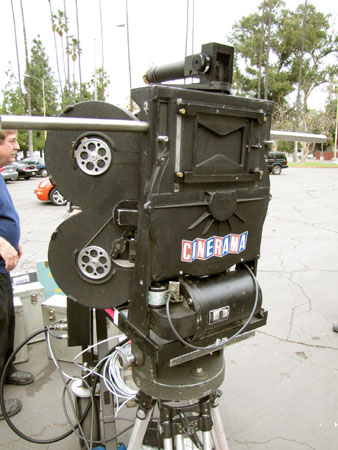 The Camera! The Camera!A viewfinder extension tube resides atop the camera and is dialed left, center and right as a ballpark reference to check “A”, “B” and “C” panel framing. The unusual design of this system does not allow for through-the-lens reference during a take. A film magazine must be removed and the special viewfinder extension is attached to the back of the lens to precisely frame a shot and set focus. For a fairly close static shot like the next one, this means the camera must not move once the focus is set. Again, light meter readings are taken and the aperture and focus are painstakingly set so that all three lenses match precisely. If the clouds shift and the light changes before a shot can be pulled off, everything stops and this process must be meticulously repeated. It’s a good deal of work and requires much more patience than that required on modern film sets. But the result is well worth the effort. Strohmaier calls “Action” and after a few more takes this location is wrapped. Seeing the camera torn down and crated inspires just a tinge of melancholy. Hard to say why. As the crew stows the gear and prepares to head off to the next setup, grabbing footage of the Disney Concert Hall in downtown Los Angeles, everyone reflects on the morning’s work and there seems to be a pleasant buzz in the air — as though we had all been involved in something akin to magic. | |
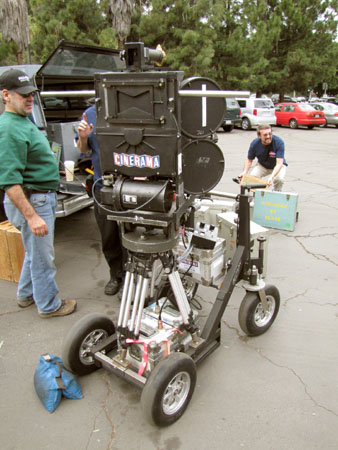 The Camera! The Camera!Cinerama enjoyed a raucous hey day in the 50’s and 60’s. And though many of Cinerama’s original three-panel films have fallen into disrepair or gone missing, they are by no means lost. In September of this year, the Cinerama Dome at the ArcLight Theatre in Hollywood will be running completely new restorations of all the Cinerama films, including many thought to have been lost. And at this festival Dave Strohmaier will also premiere his short “In the Picture”, the latest addition to the Cinerama canon. In an increasingly digital age there are many who pine for the nostalgic days of celluloid cinema. With this latest film, classic three-panel curved screen filmmaking seems to have once again found its footing. In September, the fortunate few who come to Hollywood for this epic revival will be transported. I shall be among them. | “In the Picture” in 3-strip Cinerama - Cast & Credits “In the Picture” in 3-strip Cinerama - Scripted Locations |
| Go: back - top - back issues - news index Updated 28-07-24 |
